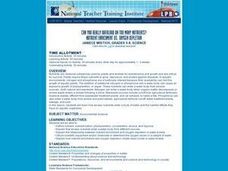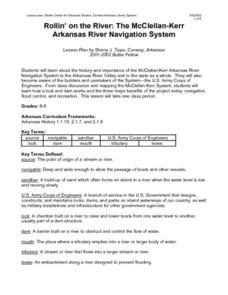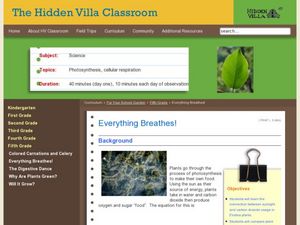Curated OER
Nutrient Enrichment vs. Oxygen Depletion
Students investigate how excess nutrients enter a body of water, and the harmful effects they have on aquatic organisms.
Curated OER
Beach Erosion Investigation
Students determine the effects of gentle and strong waves on beach erosion. They use a stream table to simulate a beach and sketch the beach profile after simulated waves of different sizes.
Curated OER
United States Map- Rivers
Students identify major rivers on a map of the United States. In this geography instructional activity, students discuss what a river is and use a map marker to identify the symbol of a river on a map.
Curated OER
The High Plains: Land of Extremes
Young scholars complete activities surrounding the study of groundwater movement, energy resources, wind energy, and riparian areas. They debate/role-play the viewpoints of different interest groups in considering whether the...
Curated OER
Science: Draining the Land - the Mississippi River
Students use topographic maps to identify parts of rivers. In addition, they discover gradient and predict changes in the channels caused by variations in water flow. Other activities include sketching a river model with a new channel...
Curated OER
Debris Dilemmas
Students examine debris, what it is, where it comes from and where they go. In this debris lesson students view a video, answer questions and discuss what they learned.
Curated OER
Rainy Day Hike
Students develop awareness about the water cycles. They identify the watershed in which their school is located. They explain the role the schoolyard plays in the watershed.
Curated OER
Science: Not just Gold
Learners articulate a possible relationship between arsenic and gold deposits in a written statement using data to substantiate the relationship they describe. They use real data to determine the source of the arsenic in the drinking...
Curated OER
The Life and Times of the West River 1776-1896: A Study of Early Industry in Westville
Students examine the role of the West River in Connecticut in providing water power to local industries. In groups, they determine and discuss what needs to be considered before building along a river. They also research the other...
Curated OER
Groundwater Pollution Site Assessment
Students study how a geologist examines a hazardous waste spill using an actual site. They use site data to map the spill, find its source and determine how fast the spill is spreading.
Curated OER
Acid Rain
Students write paragraphs and color illustrations about acid rain. They color in where gases come from, where they mix, and where they return. They discuss where acids form in the atmosphere and list manmade sources of gases.
Curated OER
Using A Winogradsky Column to Analyze Microbial Communities
Pupils use easily obtained materials to study ecological succession in a microbiological community. They collect water samples from outdoor sources in plastic bottles to observe and record changes.
Curated OER
Wetlands Project
Students discover how wetlands filter out contaminants before they can reach other bodies of water. In groups, they design and build a model of a stormwater wetland. They test the water quality and inform their classmates about the...
Curated OER
Take a Dip: Be a Field Guide
Students create a Visitor's Field Guide for the local area in order to enhance the understanding of natural features of the area for those who may be unfamiliar with the area.
California Academy of Science
Pollution in Our Watershed
The concept of a how pesticides and other chemicals pass through a watershed can be difficult for younger learners to grasp without a concrete example. In the activity here, some blank paper, markers, and a spray bottle are all you need...
K12 Reader
From Nomad to Farmer
The gradual evolution of the earliest settlers in North America from nomads to farmers is the subject of a reading comprehension learning exercise that asks kids to answer a series of questions using information provided in the reading...
Curated OER
Soil Runoff Challenge
Learners find ways to decrease soil runoff for an African Village as a part of a Peace Corps project. In this soil runoff lesson, students play a soil runoff challenge online. Learners complete online activities and view a slide show to...
Curated OER
Activist Survey
In this stewardship worksheet, students determine what actions and behaviors help to keep an environment healthy. This worksheet has 15 true or false questions.
Curated OER
Early Settlements
Students embark on a journey through colonial times. For this early settlement lesson, students come to understand what life was like for the settlers in the early colonies. Students research and create projects illustrating their new...
Curated OER
Reading in the Content Area-Leeches
Learners practice the habits of good readers in the content area of science. While reading a brief article about leeches, they compare and contrast the material read with other information they have encountered.
Curated OER
Rollin' on the River: The McClellan-Kerr Arkansas River Navigation System
Middle schoolers take a close look at the McClellan-Kerr Arkansas River Navigation system. They study how the Army Corps of Engineers built and monitor the system. Learners discover how a lock and a dam work, and study three benefits of...
NOAA
Ocean Primary Production
A cold seep is an area on the ocean floor where hydrocarbons leak from the earth, creating entire unique biomes. Learners explore cold seeps, photosynthesis in the ocean, and its limitations due to loss of sunlight. They further explore...
Curated OER
Forecasting the Path of Mudflows
Students watch a demonstration to introduce them to the consistency of mudflows and how they move. In groups, they compare and contrast volcanic avalanches and mudflows. They create their own model of a volcano, simulate how it erupts...
Curated OER
Everything Breathes!
Fifth graders test plants in the dark and in the light to see which grows better and produces more carbon dioxide. In this plants lesson plan, 5th graders also create ways for plants to go through photosynthesis that they can observe.

























